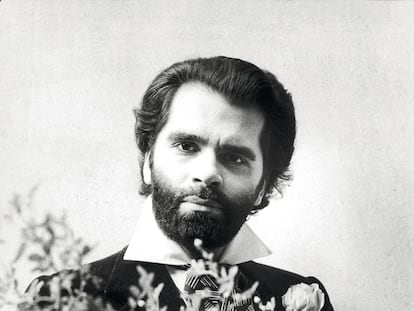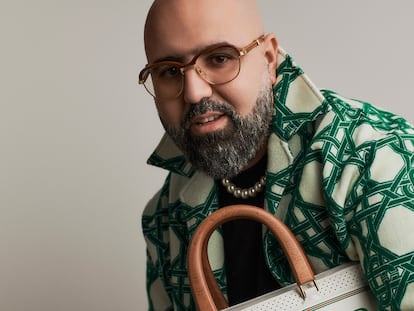Deciphering Karl Lagerfeld after his death: The mysteries of a unique and complicated personality
Many unknowns continue to shroud the figure of the German designer. Now, the questions that surround him are providing fodder for movies and series, as well as an exhibition that seeks to extol his understated artistic side
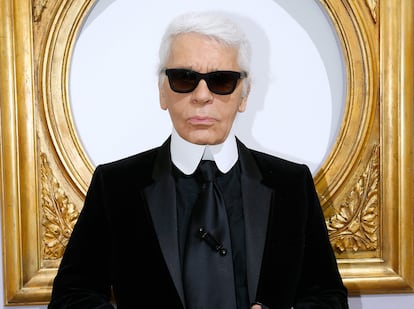
Karl Lagerfeld is continuing to make as many headlines posthumously as he did during his lifetime. Four years after his death, many of his personal effects have been auctioned for millions of dollars, his intimates are still fighting for an as-yet unresolved inheritance, his work will be the focus of the next major exhibition at the Metropolitan Museum of Art in New York and his life is the subject of a series and films. The mysteries of the German designer who revived Chanel after founder Coco’s death are still as present as they were at the time. The difference is that now many have lost their fear of talking about the ‘Kaiser’ of fashion, who was at the helm of Chanel for thirty years, served as Fendi’s creative director and eventually started his own eponymous brand.
“He had one foot in Chanel and one foot in LVMH; he absolutely controlled the fashion world. So, yes, it was very difficult to talk about him, and the moment he died it became much easier,” said Le Monde journalist Raphaëlle Bacqué, the author of the biography Kaiser Karl and the co-creator of a Disney+ series with the same title, which is currently in the works. Used to investigating the spheres of power in France, Bacqué approached Lagerfeld for a series of reports on the designer in which she talked about his family and his origins, which the designer preferred to keep quiet. Of course, Lagerfeld was not pleased, but Bacqué was motivated to keep digging.
Coincidentally, Lagerfeld died before the journalist published her book. After the designer’s death, the journalist started to receive calls from sources. “I had reached out to witnesses who hadn’t wanted to talk. But at that moment [after he died] they called me back [and said]: ‘Can we meet? Now I really want to talk.” Bacqué won’t reveal who called, but her book mentions model Inès de la Fressange — who portrayed Lagerfeld as an implacable man even with his friends — and Gilles Dufour, the former studio director at Chanel, among others.
Filming for the show Kaiser Karl began this week and will take place in France, Monaco and Italy. The series stars Spanish-German actor Daniel Brühl (Goodbye Lenin, Inglourious Basterds) in the lead role and assembles a very European cast to recreate the designer’s life and Parisian fashion in the 1970s, before Lagerfeld became an icon. Arnaud Valois will play Yves Saint-Laurent, Théodore Pellerin will depict the “venomous” dandy Jacques de Bascher, Agnès Jaoui will interpret Gaby Aghion, the creator of the Chloé brand, and Jeanne Damas, the French ‘it girl’ par excellence, will bring Paloma Picasso to life. An anecdote involving Paloma Picasso symbolizes the competition between Saint Laurent and Lagerfeld: to avoid picking sides between the two, she had one make her wedding dress for the day, while the other was responsible for the evening one.
“We wanted to create a European series that reflects what Lagerfeld was: a great European. [He was] a unique character, [he was] complicated and a liar,” said Bacqué. She goes on to insist that fashion is merely the backdrop of this series, which will discuss power and a singular time in society. In the 1970s, Lagerfeld begins to create his personality anew, backing away from some of the lies he had told when he arrived in France after World War II, such as when he claimed to be Swedish. “He was already starting to say who he was and where he came from. He lived in Paris with his mother, Elisabeth, an important character in this story, and he began to achieve great commercial success.”

There was a fierce war between him and Saint Laurent, who was internationally recognized as a great designer, while Lagerfeld did not enjoy the same prestige. The six episodes of the first season, which will be released in 2024, end precisely at the moment in which Lagerfeld’s success began with the accomplishment that accompanied him for the rest of his life: when he was hired by Chanel in 1982.
The project on which Jared Leto is currently working seems more likely to contribute to the myth of Lagerfeld. The actor himself is producing the biopic (which still doesn’t have a release date). In discussing the film, Leto legitimates himself by noting that he knew and interacted with the designer. “One day, I will play you in a movie,” Leto told Lagerfeld, as the actor recounted in an interview with Women’s Wear Daily. “Only you, my dear, only you,” the kaiser is said to have responded to him.
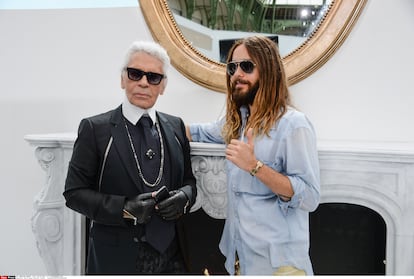
According to Bacqué, Lagerfeld’s mark on the industry has more to do with business than art: he had a fierce run designing multiple annual collections, beyond the usual winter and summer seasons, and ushered in a system based on the reign of artistic directors. He was behind the rise of many supermodels in the 1990s and was responsible for turning fashion shows into the great spectacles that they ultimately became. According to Bacqué, Lagerfeld was a businessman rather than a poetic artist.
The Metropolitan Museum of Art’s Costume Institute will combat that view with its exhibit Karl Lagerfeld: A Line of Beauty. It will examine the German’s work by emphasizing his “stylistic vocabulary” from the 1950s to his last collection in 2019, focusing on the sketches that he drew freehand in a matter of seconds. Yes, he was productive but also highly creative; as the exhibit’s curator said, Lagerfeld’s background also merits analysis. In September, Bolton was in Paris previewing the contents of the exhibit alongside Vogue USA’s Anna Wintour and singer Pharrell Williams, who was recently appointed creative director of Louis Vuitton’s men’s line.
The exhibition seems to come from Lagerfeld’s camp, since the closed-door presentation was held in the designer’s Parisian studio, and it was clearly aligned with the desire of the labels and creators to legitimize themselves within art, irrespective of the work’s commercial success. Indeed, Bolton did not refer to the show as a retrospective but rather as an “essay” about a specific aspect of Lagerfeld, “the secret code” that his lines represented.
“He drew pictures of everything; he said he started drawing before he could talk or walk. It was his main form of communication, whether [it was] by fax or iPhone,” Bolton said at the presentation. He went on to explain that the exhibit will show the evolution of those drawings from paper to three-dimensional garments.
Sponsored by Chanel and Fendi, the exhibition will showcase 150 pieces by Lagerfeld, from his work for Balmain, Patou, to Chloé, Fendi, Chanel and his own eponymous brand. At the time, Bolton argued that Lagerfeld’s creative process has not been sufficiently praised. That accounts for the efforts to decipher the “secret language” of the designer’s minimalist lines, which he used in the illustrations that he gave to his workshop managers. The Met Gala on May 1 will also pay tribute to the designer; there, we will see celebrities and creators reinterpret Lagerfeld’s universe.
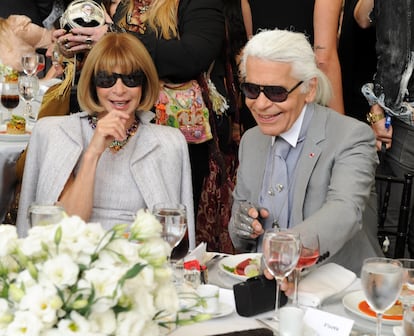
Much of the work Lagerfeld did at the fashion houses he headed consisted of reinterpreting their codes, and it continued to connect with new audiences (and sell clothing). Thus, this approach seems to be the only way to trace a direct line in Lagerfeld’s artistic career. As Wintour said of Lagerfeld, “Paradoxically, he has become a world-renowned figure while maintaining strict privacy in his life.” That same lifestyle explains the mystery of Karl Lagerfeld that journalists, producers and fashion historians are now trying to unravel.
Sign up for our weekly newsletter to get more English-language news coverage from EL PAÍS USA Edition
Tu suscripción se está usando en otro dispositivo
¿Quieres añadir otro usuario a tu suscripción?
Si continúas leyendo en este dispositivo, no se podrá leer en el otro.
FlechaTu suscripción se está usando en otro dispositivo y solo puedes acceder a EL PAÍS desde un dispositivo a la vez.
Si quieres compartir tu cuenta, cambia tu suscripción a la modalidad Premium, así podrás añadir otro usuario. Cada uno accederá con su propia cuenta de email, lo que os permitirá personalizar vuestra experiencia en EL PAÍS.
¿Tienes una suscripción de empresa? Accede aquí para contratar más cuentas.
En el caso de no saber quién está usando tu cuenta, te recomendamos cambiar tu contraseña aquí.
Si decides continuar compartiendo tu cuenta, este mensaje se mostrará en tu dispositivo y en el de la otra persona que está usando tu cuenta de forma indefinida, afectando a tu experiencia de lectura. Puedes consultar aquí los términos y condiciones de la suscripción digital.
More information
Archived In
Últimas noticias
There is as much life left to discover on planet Earth as that which is already known
Dozens presumed dead, around 100 injured in fire at Swiss Alps bar during New Year’s celebration
Is porn for women different from conventional porn? We spoke to those who make it
Cartagena de Indias is sinking: What can the city do to mitigate it?
Most viewed
- David King, chemist: ‘There are scientists studying how to cool the planet; nobody should stop these experiments from happening’
- Reinhard Genzel, Nobel laureate in physics: ‘One-minute videos will never give you the truth’
- Oona Chaplin: ‘I told James Cameron that I was living in a treehouse and starting a permaculture project with a friend’
- Sinaloa Cartel war is taking its toll on Los Chapitos
- The Interoceanic Train, the Mexican alternative to the Panama Canal
